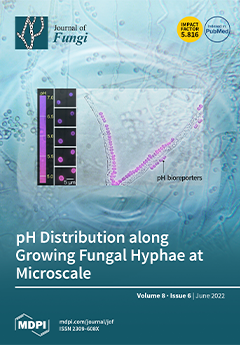Lipid assimilation, storage, and turnover impact growth, development, and virulence in many microbial pathogens including fungi. Perilipins are proteins associated with lipid droplets (LDs) that mediate their assembly and turnover. Here, we characterized the
Beauveria bassiana (
BbPlin1) perilipin.
BbPlin1 expression was higher in minimal media than in rich media, and, using a BbPlin1::eGFP fusion protein, the protein was shown to be co–localized to LDs, with the high expression seen during infection and proliferation within the insect (
Galleria mellonella) host that dramatically decreased to almost no expression during fungal outgrowth on cadavers including in conidia, but that
BbPlin1 production resumed in the conidia once placed in nutrient–containing media allowing for germination and growth. Characterization of a targeted gene deletion strain (Δ
BbPlin1) revealed a dramatic (>30%) reduction in cellular LD content, promotion of aerial hyphal growth, and a small decrease in virulence, with little to no effects on vegetative growth and stress responses. However, in the Δ
BbPlin1 strain, expression of the complementary LD–associated caleosin gene,
BbCal1, was enhanced under nutrient–poor conditions, although no changes in
BbPlin1 expression were seen in a Δ
BbCal1 strain and the expression of
BbPlin1 in the Δ
BbCal1 strain did not change LD patterns in cells. Transcriptome and RT–PCR analyses indicated increased expression of lipid metabolism–related genes, including triacylglyercol lipase 3, enoyl–CoA isomerase, and diacylglycerol–O–acetyl transferase in the
BbPlin1 deletion mutant. Lipid profile analyses confirmed that the loss of
BbPlin1 significantly reduced the cellular levels of contents of triacylglycerol, diacylglycerol, and phosphatidylethanolamine as compared to the wild–type strain. These results demonstrate the involvement of the
B. bassiana perilipin in mediating lipid homeostasis, fungal aerial hyphal growth, and virulence, revealing critical cycling from high expression during nutrient utilization within host cadavers to low expression during growth on the surface of the cadaver during the infection process.
Full article






